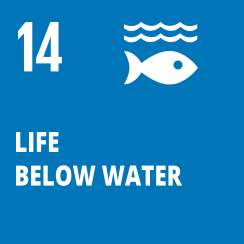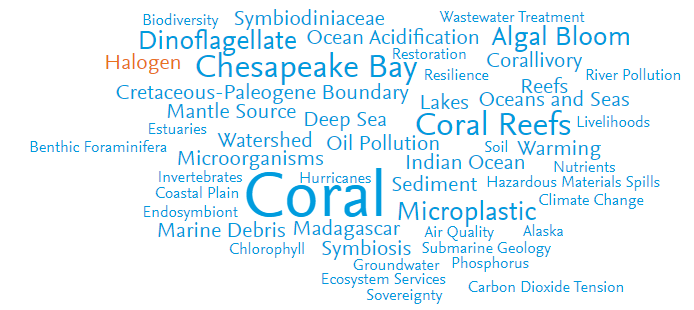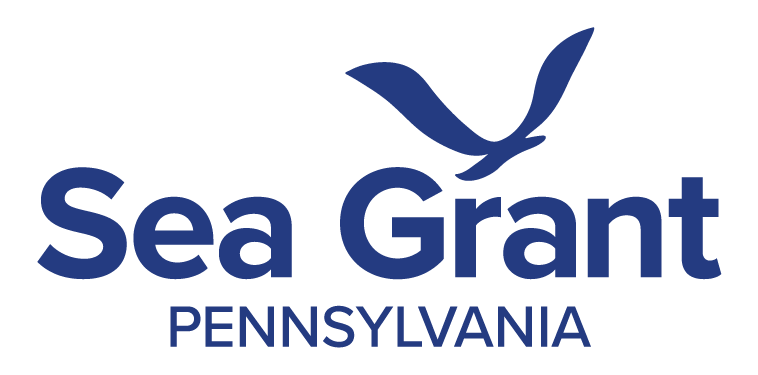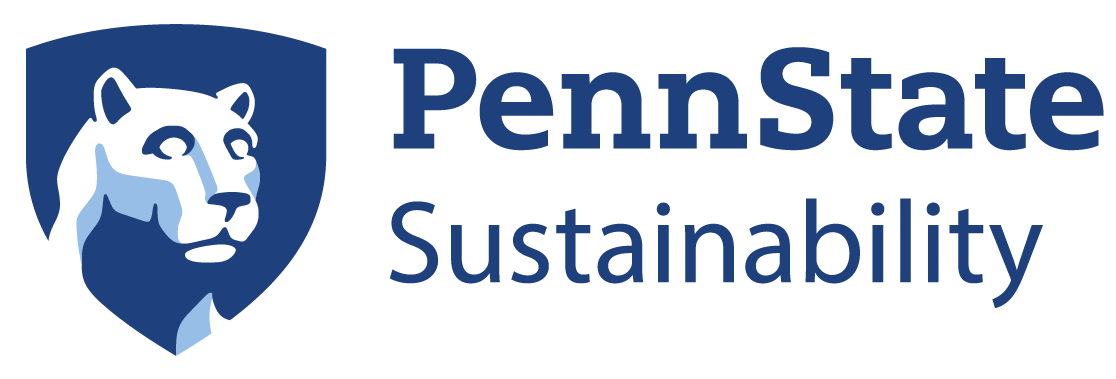
Conserve and sustainably use the oceans, seas and marine resources for sustainable development
This goal take an environmental approach by targeting efforts to reduce marine pollution; sustainably manage and protect marine and coastal ecosystems; improve ocean health and to enhance the contribution of marine biodiversity; conserve coastal and marine areas; and, minimize and address the impacts of ocean acidification through the implementation of science-based management plans. It fosters social capacity with a focus on increasing scientific knowledge, develop research capacity and transfer marine technology and prohibiting subsidies which contribute to overcapacity and overfishing. It addresses economic issues by focusing on increasing economic benefits for sustainable management of fisheries, aquaculture and tourism and provide access for small-scale artisanal fishers. See below for Penn State’s work on the targets and indicators for this goal.

Source: SciVal.com | This word cloud was created using publications from Penn State researchers
Related News
Temperature is stronger than light and flow as driver of oxygen in US rivers
The amount of dissolved oxygen in a river is a matter of life or death for the plants and animals living within it, but this oxygen concentration varies drastically from one river to another, depending [...]
Indo-Pacific corals more resilient to climate change than Atlantic corals
While describing species of algal symbionts associated with reef corals across the Indo-Pacific, an international research team led by Penn State expose flexibility in these relationships that may boost their long-term resilience to climate change. [...]
Researchers to investigate effect of perchlorate in fireworks on drinking water
Each year, millions of pounds of fireworks illuminate the skies across the United States, captivating audiences with their dazzling displays. What many people may not realize is that perchlorate, a significant ingredient in fireworks, may [...]
Some corals may survive climate change without paying a metabolic price
Some corals may survive climate change without paying a metabolic price | Penn State University (psu.edu)
Penn State researchers discover one-of-a-kind fish is local to lower Susquehanna
https://www.psu.edu/news/research/story/penn-state-researchers-discover-one-kind-fish-local-lower-susquehanna/?utm_audience=Combined&utm_source=newswire&utm_medium=email&utm_campaign=Research%20headlines%20issue&utm_content=07-27-2023-08-24&utm_term=featured
Penn State led teams shows Indo-Pacific corals more resilient to climate change
Indo-Pacific corals more resilient to climate change than Atlantic corals | Penn State University (psu.edu)
Supporting Evidence
Yes, Penn State University offers offer educational programs on fresh-water ecosystems (water irrigation practices, water management/conservation) for local or national communities. They are free and paid educational programs on topics that include fresh water ecosystems programs such as Watershed Stewards and water management and conservation programs such as pond management and watershed restoration programs. The university also offers educational programs on fresh-water ecosystems for youth that include stormwater education, watersheds, and water quality issues.
Penn State’s Agriculture and Environment Center focuses on solving water quality challenges related to the impacts of land use and land management by fostering partnerships with stakeholders engaged in land and water issues. It integrates education, research, community outreach, and extension assets to help communities and stakeholders solve land and water-related environmental problems at multiple scales.
The Penn State Extension Center provides many programs and resources about water irrigation practices, management, and conservation.
Yes, Penn State offers educational programs and outreach for local or national communities on sustainable management of fisheries, aquaculture and tourism.
As a Sea Grant university, the mission is “to enhance the use and conservation of Pennsylvania’s coastal, marine, and Great Lakes resources to create a healthy environment, resilient and inclusive communities, and a strong and sustainable economy.”
The 2024-2027 Pennsylvania Sea Grant Strategic Plan plans to address the following:
- Environmental Literacy and Workforce Development
- Healthy Coastal Ecosystems
- Resilient Communities and Economies
- Sustainable Fisheries and Aquaculture
A core value of the program is dedication to sustainability, which focuses on “Advancing environmental stewardship practices and communicating the value of the services that the coastal, watershed, ocean, and Great Lakes ecosystems provide to the nation.” Facilitating an informed public by promoting and delivering educational practices that engage participants in stewardship- and place-based learning is another core value of the Pennsylvania Sea Grant program.
The Sea Grant program collaborates with state, regional, and national programs to improve Pennsylvania’s coastal community resiliency and environmental literacy, and protect and restore its coastal, marine, and Great Lakes resources. These efforts serving on and participating in a variety of boards, committees, and organizations which include:
- Chesapeake Bay Invasive Catfish Workgroup
- Chesapeake Bay Regional Communications Committee
- Community Resilience Action Network of Erie
- Delaware County Coastal Zone Management Task Force
- Erie County Coastal Zone Management Task Force
- Great Lakes Panel on Aquatic Invasive Species
- Governor’s Invasive Species Council
- Lake Erie Region Conservancy
- Lake Erie Watershed Cooperative Weed Management Area
- Mid-Atlantic Aquatic Invasive Species Panel
- Pennsylvania Advisory Committee for Environmental Education
- Pennsylvania Association of Natural Resource Extension Professionals
- Pennsylvania Department of Environmental Protection Statewide Coastal Advisory Committee
- Pennsylvania Department of Environmental Protection Water Resources Advisory Committee
- Pennsylvania Environmental Literacy Steering Committee
- Pennsylvania Green and Healthy Schools Partnership Advisory Committee
- Pennsylvania Lake Erie Harmful Algal Bloom Taskforce
- Pennsylvania Lake Erie Watershed Association
- Pennsylvania Master Watershed Stewards Statewide Advisory Committee
- Pennsylvania Meaningful Environmental and Watershed Educational Experience Task Force
- Penn State Water Team
- Pennsylvania Water Resources Research Center External Advisory Committee
- Philadelphia Higher Education Network for Neighborhood Development
- Regional Outdoor Learning Network
- Regional Science Consortium Executive Board
- Schuylkill Action Network – Stormwater Subgroup
- School District of Philadelphia Green Futures Education for Sustainability Committee
- Sea Grant communities of practices, such as:
- Diversity, Equity, Inclusion, and Justice
- Green Infrastructure
- Hazardous Material Transport Outreach Network
- Marine Debris
Yes, the university offers educational outreach for local or national communities to raise awareness about overfishing, illegal, unreported and unregulated fishing and destructive fishing practices primarily through two key efforts.
1) Penn State administers Pennsylvania’s Sea Grant program whose strategic plan outlines how it offers educational materials and curriculum, resources and activities for local or national communities to raise awareness about overfishing, illegal, unreported and unregulated fishing and destructive fishing practices. These are featured prominently in two of the focus areas of the strategic plan: Healthy Coastal Ecosystems Goals, Actions, and Outcomes and Sustainable Fisheries and Aquaculture Goals, Actions, and Outcomes. Goals in these focus areas include:
- Coastal and Great Lakes habitats, ecosystems, and the services they provide are protected, enhanced, and/or restored.
- Land, water, and living resources are managed by applying science, tools, and services to sustain resilient coastal and Great Lakes ecosystems.
- Natural resources are sustainably managed to support coastal communities and working waterfronts, including commercial, recreational, subsistence fisheries, and aquaculture.
In the Sea Grant Strategic Plan, actions and outcomes directly related to educational outreach for local or national communities to raise awareness about overfishing, illegal, unreported and unregulated fishing and destructive fishing practices include ensuring the best available science, services, and tools available to and trusted by resource managers, fishing and aquaculture communities, and consumers in order to support:
- Commercial and recreational fishers and aquaculturists who are knowledgeable about efficient, sustainable, and responsible tools, techniques, and uses of coastal and freshwater resources.
- Resource managers and fishing and aquaculture communities access to and share diverse knowledge and tools to increase their capability to adapt to changing resource management needs, including those driven by climate change.
- Consumers understand the health and sustainability benefits of domestically produced seafood and use that knowledge to inform their seafood purchasing decisions.
2) Penn State Extension provides educational materials, webinars, and workshops for safe and sustainable fishing practices.
Yes, Penn State organizes events which promote conservation and sustainable utilization of oceans, seas, lakes, rivers, and marine resources through its Sea Grant program, Riparia Center, Extension programs, with the Pennsylvania Water Council, and through resources on the Office of Physical Plant website.
- The Sea Grant program hosts annual environmental forums focused on Lake Erie (see May 2023 Forum and archived agendas covering Hazard Mitigation and Climate Change, Per-and Polyfluoroalkyl substances (PFAS), and Environmental Justice and Equity for details on more Lake Erie specific topics).
- Riparia responds to requests for information and assistance from the University students and faculty, the University’s Office of the Physical Plant, federal and state agencies, non-governmental organizations, consulting firms, industries, schools, and citizens.
- Extension programs include webinars and workshops on the role of river basin commissions and water use, groundwater protection, water management, stream ecology, the relationship between agriculture and Chesapeake Bay water quality, and watershed-friendly property certification.
- The Water Council and Penn State’s Sustainability Institute held joint events in 2021. The Soundings water film series was co-presented by Penn State’s Sustainability Institute, Penn State’s Water Council, and WPSU. This series explored the intersecting issues surrounding water conservation and the innovative research and policy solutions addressing these issues around the world.
- A Stormwater Knowledge quiz on the Office of Physical Plant website promotes and raises awareness about watershed protection.
Penn State’s Agriculture and Environment Center Community Watershed Engagement Program brings Penn State researchers, educators and students together with community members to work directly, through research and engagement with industries, to maintain and extend existing ecosystems and their biodiversity to solve water quality problems in local priority watersheds.
The Chiques-Conoy-Conewago Regional Partnership is a diverse set of agriculture and conservation partners working together to provide sampling and data collection, outreach, technical assistance, and funding assistance to interested farmers in the region.
The Greening the Lower Susquehanna watershed engagement program engages partners and citizens to accelerate the implementation of green infrastructure to restore local streams and manage runoff.
The Sustainable Watersheds Program promotes, restores, and maintains healthy local watersheds through collaborative community engagement and engaged scholarship.
Yes, Penn State University works directly on technologies and practices that will enable the marine industry to minimize and prevent damage to aquatic ecosystems through research and community engagement projects.Examples include:
- Engaged scholarship projects focused on stormwater management;
- Extension materials, workshops and webinars on water resource management;
- Riparia Center research and tools for conservation and restoration of wetlands, wildlife, and aquatic resources;
- Sea Grant research and resources such as educational materials, fact sheets, maps, manuals, and reports;
- Curating the Water-Energy-Food Nexus Discovery Map that aids in fostering comprehensive sustainable development projects around the globe by providing filterable research and data visualization that allows users to locate areas of need, growth, partnership, and action.
Yes, Penn State does has water quality standards and guidelines for water discharges that follow EPA Clean Water Act standards. In addition, the university has Pennsylvania Department of Environmental Protection National Pollutant Discharge Elimination System permitting for all discharges to the environment.
There is a university policy to not discharge any wastewater to any surface water body.
Since 1983, spray application of all University Park wastewater goes onto a Living Filter to recharge the groundwater.
Yes, the university Waste Reduction Task Force has outlined an action plan in their 2019 Report. A primary recommendation they outlined is to encourage waste reduction across campus via reusable mugs, beverage cups, and other reusable food containers and to reduce single-use plastic bags.
The university is exploring, with the guidance of the Waste Reduction and Recycling Programs Manager and the interim director of the composting facility, how to improve the composting operation that, if done, will enable us to reduce single-use plastics and convert to compostable food service ware. The dining commons have reusable to go packaging available.
As of August, 2023, Penn State Housing and Food Services will no longer use Styrofoam products at its residential dining locations at University Park and the Commonwealth Campuses. All dining locations will use either recyclable or compostable containers. See the news story HERE.
The university Recycling Policy establishes a Recycling and Reuse Policy with a targeted goal to develop and implement a policy that will promote waste reduction at the University to include recycling, reuse, composting, and green purchasing.
Yes, Penn State University has a set of interrelated policies and plans to prevent and reduce marine pollution.
To prevent and reduce marine pollution of all kinds, in particular from land-based activities, the university has:
- a policy on disposal of pollutants
- a Stormwater Master Plan
- as part of the Susquehanna River basin the university follows the Susquehanna River Basin Commission permitting for water withdrawals to protect downstream water flows
- the Joint Pollutant Reduction Plan provides a contractual obligation for the continued monitoring of the existing Regional Chesapeake Bay Pollutant Reduction Plan and Impaired Waters Plan
- Penn State Extension Saving the Chesapeake initiative brings together farmers, industry, and government agencies to come up with science-based solutions for reducing pollutants in Pennsylvania’s watersheds impacting the Chesapeake Bay
- the Pennsylvania Department of Environmental Pollution National Pollutant Discharge Elimination System Permit regulates nutrient discharge into surface streams that flow to the Susquehanna River and to the Chesapeake Bay
Yes, the university has several long-standing plans that are followed to minimize alterations of aquatic ecosystems related to campus. Key examples include:
- Treated effluent from Penn State’s wastewater treatment plant (WWTP) has been land-applied year-round at sprayfields – the “Living Filter” – since 1983 rather than stream-discharged. An estimated 90% of the irrigated water, over 500 million gallons per year, recharges the region’s water table. The land application of treated wastewater helps to maintain base flows in streams and reduces the impacts of drought conditions.
- The SY40 Disposal of Pollutants in University Sanitary Systems policy prohibits the disposal of materials that could adversely affect the general public or wastewater personnel in the course of their work, could interfere with the operation of the University Sanitary Sewer system, or could pass through inadequately treated into the environmen
- Penn State’s WWTP has not discharged to Thompson Run since 1983 and is thought to be one of the many reasons that the water quality of Spring Creek is considered to be better now than any time in the last 100 years.
- Penn State University has extensive stormwater management on site to minimize impacts to surface water bodies and streams. The University overall is a net zero discharger of surface runoff.
Learn more about university water conservation and preservation plans and practices here.
Yes, the university uses several approaches to monitor the health of aquatic ecosystems.
The university has water quality sampling in surface waters where we discharge to as part of our stormwater management program which is described in the Stormwater Guidance, Policies, and Master Plan document.
The Riparia Center on the University Park campus conducts long-term studies of the ecology and management of wetlands, streams, and riparian areas across the Commonwealth on a watershed basis, develops and tests ecological indicators for wetlands, streams, and forests.
The university also partners with local agencies and organizations (Trout Unlimited, Spring Creek Watershed Management, etc.) to monitor water quality in the Centre Region.
Yes, Penn State University Penn State develops, supports, and offers programs that encourage and maintain good aquatic stewardship practices. For example:
University Extension developed and offers a Watershed Stewards program which encourages good aquatic stewardship practices.
University Extension developed and offers water management and conservation programs such as pond management and watershed restoration programs.
The university has developed programs such as a Water Resources Preservation (WRP) land-use classification for approximately 455 acres of land at University Park which has resulted in the University overall becoming a net zero discharger of surface runoff.
The university completed the first Source Water Protection Plan in the region and has adopted a fundamental philosophy that all new development and redevelopment projects at the University have the goal of reducing peak runoff rates downstream.
Penn State’s Extension offers webinars, workshops, and articles about water quality and management that are available for free online to all. The Penn State Agriculture and Environment Center is focused on solving today’s water quality challenges related to the impacts of land use and land management.
Yes, Penn State partners with numerous local community organizations to maintain shared aquatic ecosystems.
Partners include Spring Creek Watershed Management, Trout Unlimited, the local townships, and the Borough of State College. Together, we evaluate and manage water quality in the region, primarily through the Municipal Separate Storm Sewer Systems Partnership with Ferguson, Harris, Patton, and College Townships and the Borough of State College.
Penn State’s Agriculture and Environment Center Community Watershed Engagement Program brings Penn State researchers, educators and students together with community members to solve water quality problems in local priority watersheds.
Yes. the university has implemented a watershed management strategy that is location specific to protect aquatic diversity outlined in the stormwater management permit (MS4 permitting – Municipal Separate Storm Sewer System).
An example of a strategy included are limitations on temperature of stormwater discharge to the environment to protect the downstream cold water fishery known as Spring Creek. An overview of Spring Creek explain how it interacts with campus and the stream conditions report reflect impacts of discharges.
No
Targets & Indicators
Target 14.1: By 2025, prevent and significantly reduce marine pollution of all kinds, in particular from land-based activities, including marine debris and nutrient pollution
- Indicator 14.1.1: (a) Index of coastal eutrophication; and (b) plastic debris density
Target 14.2: By 2020, sustainably manage and protect marine and coastal ecosystems to avoid significant adverse impacts, including by strengthening their resilience, and take action for their restoration in order to achieve healthy and productive oceans
- Indicator 14.2.1: Number of countries using ecosystem-based approaches to managing marine areas
Target 14.3: Minimize and address the impacts of ocean acidification, including through enhanced scientific cooperation at all levels
- Indicator 14.3.1: Average marine acidity (pH) measured at agreed suite of representative sampling stations
Target 14.4: By 2020, effectively regulate harvesting and end overfishing, illegal, unreported and unregulated fishing and destructive fishing practices and implement science-based management plans, in order to restore fish stocks in the shortest time feasible, at least to levels that can produce maximum sustainable yield as determined by their biological characteristics
- Indicator 14.4.1: Proportion of fish stocks within biologically sustainable levels
Target 14.5: By 2020, conserve at least 10 per cent of coastal and marine areas, consistent with national and international law and based on the best available scientific information
- Indicator 14.5.1: Coverage of protected areas in relation to marine areas
Target 14.6: By 2020, prohibit certain forms of fisheries subsidies which contribute to overcapacity and overfishing, eliminate subsidies that contribute to illegal, unreported and unregulated fishing and refrain from introducing new such subsidies, recognizing that appropriate and effective special and differential treatment for developing and least developed countries should be an integral part of the World Trade Organization fisheries subsidies negotiation4
- Indicator 14.6.1: Degree of implementation of international instruments aiming to combat illegal, unreported and unregulated fishing
Target 14.7: By 2030, increase the economic benefits to small island developing States and least developed countries from the sustainable use of marine resources, including through sustainable management of fisheries, aquaculture and tourism
- Indicator 14.7.1: Sustainable fisheries as a proportion of GDP in small island developing States, least developed countries and all countries
Target 14.a: Increase scientific knowledge, develop research capacity and transfer marine technology, taking into account the Intergovernmental Oceanographic Commission Criteria and Guidelines on the Transfer of Marine Technology, in order to improve ocean health and to enhance the contribution of marine biodiversity to the development of developing countries, in particular small island developing States and least developed countries
- Indicator 14.a.1: Proportion of total research budget allocated to research in the field of marine technology
Target 14.b: Provide access for small-scale artisanal fishers to marine resources and markets
- Indicator 14.b.1: Degree of application of a legal/regulatory/ policy/institutional framework which recognizes and protects access rights for small-scale fisheries
Target 14.c: Enhance the conservation and sustainable use of oceans and their resources by implementing international law as reflected in the United Nations Convention on the Law of the Sea, which provides the legal framework for the conservation and sustainable use of oceans and their resources, as recalled in paragraph 158 of “The future we want”
- Indicator 14.c.1: Number of countries making progress in ratifying, accepting and implementing through legal, policy and institutional frameworks, ocean-related instruments that implement international law, as reflected in the United Nations Convention on the Law of the Sea, for the conservation and sustainable use of the oceans and their resources







